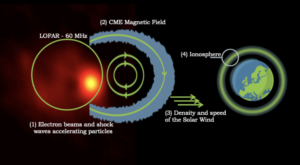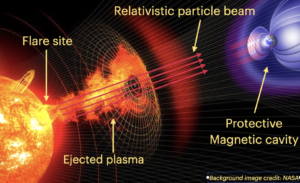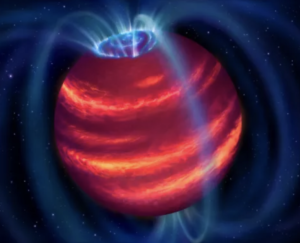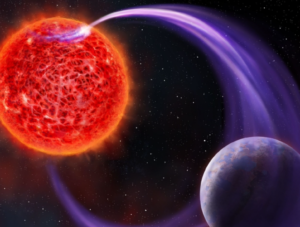The Earth sits inside a dynamic and active heliosphere where the Sun's atmosphere, the solar corona, continually expands through interplanetary space at supersonic speeds as the solar wind, carrying with it the interplanetary magnetic field. Solar flaring low down in the corona generates strong electromagnetic emission which propagates to low radio frequencies as the flare disperses with increasing altitude above the solar surface. Occasionally, large eruptions of solar material, known as Coronal Mass Ejections (CMEs), launch dense and highly-magnetised material at high speeds through the solar wind. These conditions drive processes in the Earth’s magnetosphere and ionosphere which can result in spectacular displays of the northern (and southern) lights, but also can strongly affect the satellite communications, navigation systems and power grids upon which we now rely.
SOLAR PHYSICS
People involved: Pietro Zucca
The release of magnetic energy in the solar corona is often accompanied by the acceleration of particles that emit light across the electromagnetic spectrum, from gamma rays through to radio. The quiet Sun always glows in radio emission, while escaping electron beams and fast CMEs often light up in the radio wavelengths, with the wide bandwidth of LOFAR able to provide imaging spectroscopy of the sources as they propagate up through the upper corona. LOFAR measures such events in extremely high resolution, providing diagnostics of particle acceleration, transport, and escape into the heliosphere, as well as the characteristics of the radio wave propagation itself. The high frequency and time resolution observations of solar radio bursts possible with LOFAR provide an excellent means of studying fine structure in the radio bursts, probing the turbulent density environment of the corona. In addition, the evolution of solar transients from the Sun through the solar corona, and the physical characteristics of the shock region and related radio emission, can be performed with unprecedented detail thanks to LOFAR. The small-scale coronal structures necessitate using simultaneous high temporal/spectral cadence beamformed observations and high spatial resolution interferometric observations, to localise smaller-scale solar structures. LOFAR is a remarkable instrument to conduct spectro-imaging studies of the Sun. The spectroscopic detail and high-resolution imaging of solar radio bursts possible with LOFAR is leading to new insights into the fundamental physics of the solar corona.
Observing across the LBA and HBA bands allows the full tracking of solar radio bursts and CMEs from closer to their origin in the low solar corona out into the upper corona with unprecedented spectral and spatial resolutions. Solar radio burst activity and CMEs are highly unpredictable, which makes regular monitoring of the Sun essential to be able to catch events as they happen; the biggest solar flare of the current solar cycle was missed by LOFAR and the second biggest only half observed by LOFAR due to limited observing time. The LOFAR4SW extension to the LOFAR2.0 upgrade will enable such monitoring to take place in parallel with regular radio astronomy observations. International stations offer great individual sensitivity and longitudinal coverage which enables detailed spectroscopic observations of the Sun to be made over a longer duration each day.

SOLAR WIND & INTERPLANETARY MAGNETIC FIELD
People involved: Richard Fallows, Caterina Tiburzi
Interplanetary scintillation - IPS, the scintillation of signals from compact radio sources due to small-scale density structure in the solar wind - has been used for studies of the solar wind for over half a century. Many observations taken over a whole solar rotation can be used to image the 3-D structure of both the speed and density of the solar wind throughout the inner heliosphere. Such measurements represent the only ground-based method by which the 3-D solar wind can be probed and efforts are now underway to incorporate them into space weather forecasting models.
The unique capabilities of LOFAR can be used to not only obtain highly-accurate information on the bulk flow of the solar wind, but also to delve into the scintillation itself to study the underlying turbulence giving rise to it. By employing effectively intensity interferometry techniques, the structure of both the scintillating components of the radio source and the turbulence of the intervening solar wind can be revealed. This shows the anisotropic nature of the density fluctuations, their scale size, their alignment with the interplanetary magnetic field, and their flow with the solar wind. Applying this to an observation of a CME revealed rotation of the magnetic field during the CME passage, and separated both CME and background solar wind structure to reveal the latter deviated from its usual radial direction. This technique potentially allows any fine-scale changes in velocity or density structures to be investigated in a way that cannot be achieved with other instruments.
The full impact of space weather events on the Earth’s space environment is heavily dependent on the strength and direction of the interplanetary magnetic field, carried outwards from the Sun by the solar wind, when it encounters the Earth’s magnetosphere. Measurement of the Faraday Rotation (FR) of an incoming polarised radio signal, such as from a pulsar, due to the presence of a magnetic field in the line of sight represents the foremost technique by which multiple measurements of this essential parameter can be accomplished. However, this requires great accuracy in the polarisation measurement, and subtraction of the interstellar and ionospheric components which make up the bulk of the contribution to this measurement.
THE IONOSPHERE
People involved: Richard Fallows, Maaijke Meevius
At the low observing frequencies of LOFAR, accurate modelling of ionospheric turbulence is still a significant challenge in terms of achieving the sharpest possible radio images (such techniques continue to be pioneered in the Netherlands). Dynamics in the ionosphere are driven both from below, where gravity waves generated in the lower atmosphere can propagate upwards to form travelling ionospheric disturbances, and from above as the ionosphere acts as the footprint for the constant buffeting of the Earth's magnetosphere by the solar wind, a constant outflow at supersonic speeds of solar material through the solar system. The resulting turbulence makes images of astronomical radio sources shift and shimmer in the same way as the visible stars in the night sky appear to “twinkle” due to the lower atmosphere, an effect known as scintillation.
The scintillation contains valuable information about the ionospheric density structures and flows which give rise to it. The unique LOFAR combination of wide bandwidth, enabling a wide range of density scales to be probed simultaneously, and the distribution of stations across a large geographical area, across which the turbulence pattern can be seen flowing in station auto-correlation data, enables the physics of the scintillation to be studied and characterised in a way that cannot be achieved with any other single instrument. With LOFAR we can develop a better understanding of the turbulence energy cascade, refine propagation models of radio waves through the ionosphere, and understand the link between plasma structures and corresponding perturbations in the intensity and phase of the received signal. It is only through these kinds of studies that the origin of these perturbations can be understood and methods found to model the scintillation and correct radio imaging for its effects.
STELLAR CORONAE & MASS EJECTIONS
People involved: Harish Vedantham
The space weather environment around the Earth is formed by a constant wind of plasma that streams from the Sun and occasional bulk ejection of plasma and high energy particles from the Sun. The space weather environment can have a detrimental effect on the atmospheres of planets. Using LOFAR, dr. Vedantham's group is studying the corona of stars other than the Sun. LOFAR is uniquely suited for this due to a combination of its unprecedented sensitivity and large field of view. The radio waves from stellar corona encode information about the physical conditions of the corona (density and magnetic field strength for example), the size and shape of the corona and the presence of plasma ejection events. These studies are providing much-needed inputs to models of exoplanet space weather and their atmospheric evolution over billion-year timescales. dr. Vedantham received a Starting grant from the European Research Council for a project titled STORM-CHASER which will enable the group to carry out the largest search ever for signatures of large coronal plasma ejection events on stars other than the Sun. The project will search over 10,000 stars using over 10 petabytes of data from the ongoing LOFAR Two Metre Sky Survey to discover these elusive events and provide empirical constraints on the plasma environment of exoplanets. Separately, the group is also collaborating with Prof. Aline's group at Leiden University to combine the radio data and state-of-the-art stellar wind simulations to determine the properties of stellar winds that exoplanets around so-called red dwarf stars are subjected to. This is particularly interesting because a majority of rocky Earth-like planets in the canonical habitable zone likely orbit around a red dwarf star and the strong magnetic activity of these stars might have a catastrophic effect on the ability of their planets to host life.

EXOPLANETS & BROWN DWARFS
People involved: Harish Vedantham
The fate of exoplanets' atmospheres depends crucially on their interaction with the plasma wind of their host star. The main defence mechanism exoplanets have against the stellar plasma is their magnetic fields. Indeed, the Earth's magnetic field protects our atmosphere from solar plasma whereas Mars, which does not have a large-scale magnetic field is thought to have lost half of its atmosphere to erosion by the solar wind. Perhaps the only viable technique to measure the magnetic fields of exoplanets is by observing their cyclotron emission that falls in the radio-wave band at low frequencies (below about 100 MHz). All magnetised solar system planets are bright radio emitters but such emission has never been detected on an extrasolar planet so far mainly due to a lack of sensitivity of previous low-frequency telescopes.
At ASTRON, we are using the unprecedented sensitivity of LOFAR to search for radio-emitting exoplanets and measure their magnetic fields to determine how likely they are to protect their atmospheres.
LOFAR's frequency span makes it sensitive to gas giant exoplanets such as Jupiter and brown dwarfs which are more massive cousins of gas-giant exoplanets. Although. direct detection of an exoplanet has remained elusive so far, LOFAR is already discovering the coldest brown dwarfs that are most alike gas-giant exoplanets. At ASTRON, we are using these discoveries and follow-up radio observations with LOFAR, GMRT and JVLA telescopes to measure the magnetic fields of the coldest brown dwarfs and test the so-called dynamo scaling laws that predict the magnetic fields strengths of exoplanets.

Exoplanets can also be detected in the radio-wave band indirectly because of the emission they induce on their host stars. When an exoplanet is in a sufficiently short orbit, it can tug at the star's magnetic field lines creating a type of magnetic wave called an Alfven wave. These waves bring energy back to the star where it is converted to radio waves that can be observed with LOFAR. This type of magnetic interaction between a star and a planet does not occur in the solar system because the Sun has a rather weak large-scale magnetic field. It was however discovered many decades ago when astronomers realised that a component of Jovian radio emission is being induced by magnetic interaction with the moon Io. Calculations show that a star-planet magnetic interaction can be quite common between red dwarf stars and their rocky exoplanet, even the ones in the conventional habitable zone. With LOFAR, we have obtained tantalising evidence of such star-planet interaction. We are conducting long term monitoring campaigns of such systems to conclusively detect the induction by an exoplanet. We are also conducting such campaigns on brown dwarfs with an aim to discover exoplanets orbiting brown dwarfs that are very hard to detect via conventional means.
